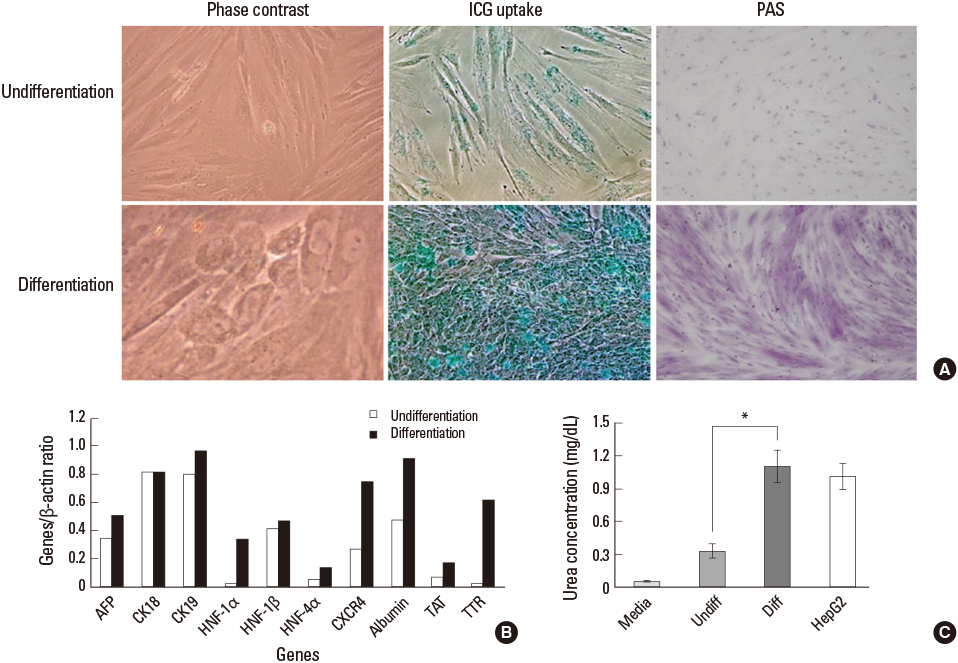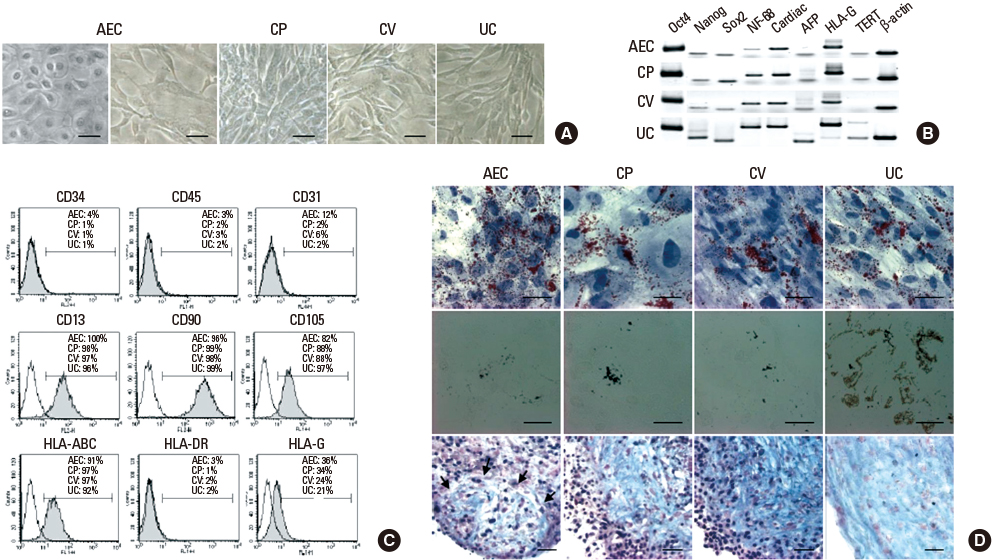Hanyang Med Rev.
2015 Nov;35(4):207-214. 10.7599/hmr.2015.35.4.207.
Advanced Research on Stem Cell Therapy for Hepatic Diseases: Potential Implications of a Placenta-derived Mesenchymal Stem Cell-based Strategy
- Affiliations
-
- 1Department of Biomedical Science, CHA University, Seongnam, Korea. gjkim@cha.ac.kr
- KMID: 2129473
- DOI: http://doi.org/10.7599/hmr.2015.35.4.207
Abstract
- The category of chronic liver diseases comprise one of the most common medical diagnoses worldwide. Currently, orthotopic liver transplantation is the only effective treatment for end-stage hepatic disease, but this procedure is associated with many problems, including donor scarcity, operative damage, high cost, risk of immune rejection and lifelong immunosuppressive treatments. Thus, the development of new therapies is highly desirable. Cell therapy with stem cells is increasingly being used to repair damaged tissue or to promote organ regeneration. Stem cells, which possess self-renewal activity as well as differentiation potential, can be categorized as embryonic stem cells (ESCs) or adult stem cells (ASCs), which include hematopoietic stem cells (HSCs) and mesenchymal stem cells (MSCs). Recently, placenta-derived mesenchymal stem cells (PD-MSCs) have been reported, and they are attracting much interest in stem cell research for their multiple advantages: 1) no ethical concerns, 2) the ability to obtain abundant cell numbers, 3) multi-lineage differentiation potential, and 4) strong immunosuppressive properties. PD-MSCs differentiate into hepatocyte-like cells when exposed to hepatogenic differentiation-inducing conditions and PD-MSCs transplantation has been shown to enhance hepatic regeneration and/or survival in a rat hepatic failure model by suppressing the progression of fibrosis and apoptosis and activating autophagy. In this review, we will explain the characteristics of several kinds of PD-MSCs and discuss recent studies of the therapeutic potential of PD-MSCs in the repair of liver injury and their utility in regenerative medicine. Although many problems remain to be solved, many studies support the potential for human stem cell therapies, including PD-MSCs, as a promising new technology for the therapeutic regeneration of human liver intractably damaged due to chronic disease and/or toxic and environmental insult.
Keyword
MeSH Terms
-
Adult Stem Cells
Animals
Apoptosis
Autophagy
Cell Count
Cell Transplantation
Cell- and Tissue-Based Therapy
Chronic Disease
Diagnosis
Embryonic Stem Cells
Fibrosis
Hematopoietic Stem Cells
Humans
Liver
Liver Diseases
Liver Failure
Liver Transplantation
Mesenchymal Stromal Cells
Rats
Regeneration
Regenerative Medicine
Stem Cell Research
Stem Cells*
Tissue Donors
Figure
Cited by 1 articles
-
New Horizons in Stem Cell Research
Dongho Choi
Hanyang Med Rev. 2015;35(4):187-189. doi: 10.7599/hmr.2015.35.4.187.
Reference
-
1. Thomson JA, Itskovitz-Eldor J, Shapiro SS, Waknitz MA, Swiergiel JJ, Marshall VS, et al. Embryonic stem cell lines derived from human blastocysts. Science. 1998; 282:1145–1147.
Article2. Pittenger MF, Mackay AM, Beck SC, Jaiswal RK, Douglas R, Mosca JD, et al. Multilineage potential of adult human mesenchymal stem cells. Science. 1999; 284:143–147.
Article3. Daley GQ, Scadden DT. Prospects for stem cell-based therapy. Cell. 2008; 132:544–548.
Article4. Michalopoulos GK. Liver regeneration. J Cell Physiol. 2007; 213:286–300.
Article5. Aberg F, Isoniemi H, Hockerstedt K. Long-term results of liver transplantation. Scad J Surg. 2011; 100:14–21.
Article6. Fisher RA, Strom SC. Human hepatocyte transplantation: worldwide results. Transplantation. 2006; 82:441–449.
Article7. Nussler A, Konig S, Ott M, Sokal E, Christ B, Thasler W, et al. Present status and perspectives of cell-based therapies for liver diseases. J Hepatol. 2006; 45:144–159.
Article8. Petersen BE, Bowen WC, Patrene KD, Mars WM, Sullivan AK, Murase N, et al. Bone marrow as a potential source of hepatic oval cells. Science. 1999; 284:1168–1170.
Article9. Lee MJ, Jung J, Na KH, Moon JS, Lee HJ, Kim JH, et al. Anti-fibrotic effect of chorionic plate-derived mesenchymal stem cells isolated from human placenta in a rat model of ccl(4)-injured liver: Potential application to the treatment of hepatic diseases. J Cell Biochem. 2010; 111:1453–1463.
Article10. Sakaida I, Terai S, Yamamoto N, Aoyama K, Ishikawa T, Nishina H, et al. Transplantation of bone marrow cells reduces ccl4-induced liver fibrosis in mice. Hepatology. 2004; 40:1304–1311.
Article11. Oyagi S, Hirose M, Kojima M, Okuyama M, Kawase M, Nakamura T, et al. Therapeutic effect of transplanting hgf-treated bone marrow mesenchymal cells into CCl4-injured rats. J Hepatol. 2006; 44:742–748.
Article12. Kuo TK, Hung SP, Chuang CH, Chen CT, Shih YR, Fang SC, et al. Stem cell therapy for liver disease: parameters governing the success of using bone marrow mesenchymal stem cells. Gastroenterology. 2008; 134:2111–2121.
Article13. Zhao DC, Lei JX, Chen R, Yu WH, Zhang XM, Li SN, et al. Bone marrow-derived mesenchymal stem cells protect against experimental liver fibrosis in rats. World J Gastroenterol. 2005; 11:3431–3440.
Article14. Carvalho AB, Quintanilha LF, Dias JV, Paredes BD, Mannheimer EG, Carvalho FG, et al. Bone marrow multipotent mesenchymal stromal cells do not reduce fibrosis or improve function in a rat model of severe chronic liver injury. Stem Cells. 2008; 26:1307–1314.
Article15. Higashiyama R, Inagaki Y, Hong YY, Kushida M, Nakao S, Niioka M, et al. Bone marrow-derived cells express matrix metalloproteinases and contribute to regression of liver fibrosis in mice. Hepatology. 2007; 45:213–222.
Article16. Jung KH, Shin HP, Lee S, Lim YJ, Hwang SH, Han H, et al. Effect of human umbilical cord blood-derived mesenchymal stem cells in a cirrhotic rat model. Liver Int. 2009; 29:898–909.
Article17. Broxmeyer HE, Douglas GW, Hangoc G, Cooper S, Bard J, English D, et al. Human umbilical cord blood as a potential source of transplantable hematopoietic stem/progenitor cells. Proc Natl Acad Sci U S A. 1989; 86:3828–3832.
Article18. Peled T, Glukhman E, Hasson N, Adi S, Assor H, Yudin D, et al. Chelatable cellular copper modulates differentiation and self-renewal of cord blood-derived hematopoietic progenitor cells. Exp Hematol. 2005; 33:1092–1100.
Article19. Vishnubalaji R, Al-Nbaheen M, Kadalmani B, Aldahmash A, Ramesh T. Comparative investigation of the differentiation capability of bone-marrow- and adipose-derived mesenchymal stem cells by qualitative and quantitative analysis. Cell Tissue Res. 2012; 347:419–427.
Article20. Lee JM, Jung J, Lee HJ, Jeong SJ, Cho KJ, Hwang SG, et al. Comparison of immunomodulatory effects of placenta mesenchymal stem cells with bone marrow and adipose mesenchymal stem cells. Int Immunopharmacol. 2012; 13:219–224.
Article21. Abdulrazzak H, Moschidou D, Jones G, Guillot PV. Biological characteristics of stem cells from foetal, cord blood and extraembryonic tissues. J R Soc Interface. 2010; 7:Suppl 6. S689–S706.
Article22. Fukuchi Y, Nakajima H, Sugiyama D, Hirose I, Kitamura T, Tsuji K. Human placenta-derived cells have mesenchymal stem/progenitor cell potential. Stem Cells. 2004; 22:649–658.
Article23. In 't Anker PS, Scherjon SA, Kleijburg-van der Keur C, de Groot-Swings GM, Claas FH, Fibbe WE, et al. Isolation of mesenchymal stem cells of fetal or maternal origin from human placenta. Stem Cells. 2004; 22:1338–1345.24. Kim MJ, Shin KS, Jeon JH, Lee DR, Shim SH, Kim JK, et al. Human chorionic-plate-derived mesenchymal stem cells and wharton's jelly-derived mesenchymal stem cells: a comparative analysis of their potential as placenta-derived stem cells. Cell Tissue Res. 2011; 346:53–64.
Article25. Marcus AJ, Woodbury D. Fetal stem cells from extra-embryonic tissues: do not discard. J Cell Mol Med. 2008; 12:730–742.
Article26. Parolini O, Alviano F, Bagnara GP, Bilic G, Buhring HJ, Evangelista M, et al. Concise review: isolation and characterization of cells from human term placenta: outcome of the first international workshop on placenta derived stem cells. Stem Cells. 2008; 26:300–311.
Article27. Lee HJ, Cha KE, Hwang SG, Kim JK, Kim GJ. In vitro screening system for hepatotoxicity: comparison of bone-marrow-derived mesenchymal stem cells and placenta-derived stem cells. J Cell Biochem. 2011; 112:49–58.
Article28. Lee HJ, Jung J, Cho KJ, Lee CK, Hwang SG, Kim GJ. Comparison of in vitro hepatogenic differentiation potential between various placenta-derived stem cells and other adult stem cells as an alternative source of functional hepatocytes. Differentiation. 2012; 84:223–231.
Article29. Carbone A, Paracchini V, Castellani S, Di Gioia S, Seia M, Colombo C, et al. Human amnion-derived cells: prospects for the treatment of lung diseases. Curr Stem Cell Res Ther. 2014; 9:297–305.
Article30. Tan JL, Chan ST, Lo CY, Deane JA, McDonald CA, Bernard CC, et al. Amnion cell-mediated immune modulation following bleomycin challenge: controlling the regulatory t cell response. Stem Cell Res Ther. 2015; 6:8.
Article31. Mohr S, Portmann-Lanz CB, Schoeberlein A, Sager R, Surbek DV. Generation of an osteogenic graft from human placenta and placenta-derived mesenchymal stem cells. Reprod Sci. 2010; 17:1006–1015.
Article32. Portmann-Lanz CB, Schoeberlein A, Huber A, Sager R, Malek A, Holzgreve W, et al. Placental mesenchymal stem cells as potential autologous graft for pre- and perinatal neuroregeneration. Am J Obstet Gynecol. 2006; 194:664–673.
Article33. Abumaree MH, Al Jumah MA, Kalionis B, Jawdat D, Al Khaldi A, Abomaray FM, et al. Human placental mesenchymal stem cells (pmscs) play a role as immune suppressive cells by shifting macrophage differentiation from inflammatory m1 to anti-inflammatory m2 macrophages. Stem cell Rev. 2013; 9:620–641.
Article34. Weiss ML, Medicetty S, Bledsoe AR, Rachakatla RS, Choi M, Merchav S, et al. Human umbilical cord matrix stem cells: preliminary characterization and effect of transplantation in a rodent model of parkinson's disease. Stem Cells. 2006; 24:781–792.
Article35. Vackova I, Czernekova V, Tomanek M, Navratil J, Mosko T, Novakova Z. Absence of maternal cell contamination in mesenchymal stromal cell cultures derived from equine umbilical cord tissue. Placenta. 2014; 35:655–657.
Article36. Jung J, Choi JH, Lee Y, Park JW, Oh IH, Hwang SG, et al. Human placenta-derived mesenchymal stem cells promote hepatic regeneration in ccl4-injured rat liver model via increased autophagic mechanism. Stem Cells. 2013; 31:1584–1596.
Article37. Hodge A, Lourensz D, Vaghjiani V, Nguyen H, Tchongue J, Wang B, et al. Soluble factors derived from human amniotic epithelial cells suppress collagen production in human hepatic stellate cells. Cytotherapy. 2014; 16:1132–1144.
Article38. Manuelpillai U, Tchongue J, Lourensz D, Vaghjiani V, Samuel CS, Liu A, et al. Transplantation of human amnion epithelial cells reduces hepatic fibrosis in immunocompetent CCl4-treated mice. Cell Transplant. 2010; 19:1157–1168.
Article39. Cargnoni A, Gibelli L, Tosini A, Signoroni PB, Nassuato C, Arienti D, et al. Transplantation of allogeneic and xenogeneic placenta-derived cells reduces bleomycin-induced lung fibrosis. Cell Transplant. 2009; 18:405–422.
Article40. Liu C, Tao Q, Sun M, Wu JZ, Yang W, Jian P, et al. Kupffer cells are associated with apoptosis, inflammation and fibrotic effects in hepatic fibrosis in rats. Lab Invest. 2010; 90:1805–1816.
Article41. Liu W, Morschauser A, Zhang X, Lu X, Gleason J, He S, et al. Human placenta-derived adherent cells induce tolerogenic immune responses. Clin Transl Immunology. 2014; 3:e14.
Article42. Aggarwal S, Pittenger MF. Human mesenchymal stem cells modulate allogeneic immune cell responses. Blood. 2005; 105:1815–1822.
Article43. Fujisaki J, Wu J, Carlson AL, Silberstein L, Putheti P, Larocca R, et al. In vivo imaging of treg cells providing immune privilege to the haematopoietic stem-cell niche. Nature. 2011; 474:216–219.
Article44. Jones BJ, Brooke G, Atkinson K, McTaggart SJ. Immunosuppression by placental indoleamine 2,3-dioxygenase: a role for mesenchymal stem cells. Placenta. 2007; 28:1174–1181.
Article45. Yagi H, Soto-Gutierrez A, Parekkadan B, Kitagawa Y, Tompkins RG, Kobayashi N, et al. Mesenchymal stem cells: mechanisms of immunomodulation and homing. Cell Transplant. 2010; 19:667–679.
Article46. Dawe GS, Tan XW, Xiao ZC. Cell migration from baby to mother. Cell Adh Migr. 2007; 1:19–27.
Article47. Schultz KM, Kyburz KA, Anseth KS. Measuring dynamic cell-material interactions and remodeling during 3d human mesenchymal stem cell migration in hydrogels. Proc Natl Acad Sci U S A. 2015; 112:E3757–E3764.
Article48. Jung J, Moon JW, Choi JH, Lee YW, Park SH, Kim GJ. Epigenetic alterations of il-6/stat3 signaling by placental stem cells promote hepatic regeneration in a rat model with ccl4-induced liver injury. Int J Stem Cells. 2015; 8:79–89.
Article




